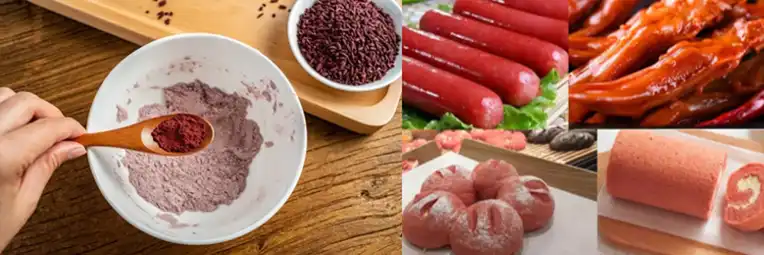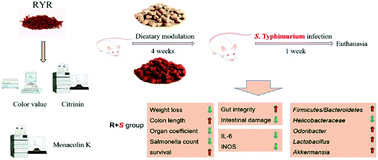Monascus Red: The Natural Choice for Vibrant, Health-Conscious Color Solutions
In today’s world, where consumers are increasingly attentive to the ingredients in their food, natural colorants have become essential. One standout among these is Monascus Red, a natural pigment that provides a brilliant red to purple hue. Extracted from the Monascus purpureus fungus, Monascus Red is valued for its rich color, stability, and compatibility with clean-label requirements.
But what makes Monascus Red such an appealing choice? Let’s dive into its unique properties and benefits for food manufacturers and consumers alike.
What is Monascus Red?
Monascus Red is derived from the fermentation of the Monascus purpureus fungus, a source that has been used traditionally in Asian cuisine for centuries. While traditionally used in foods like red yeast rice, today Monascus Red is popular as a versatile natural colorant for various food and beverage applications. Its color ranges from deep red to a purplish-red tone, making it perfect for adding visual appeal to a wide range of products.

Top Advantages of Using Monascus Red as a Natural Colorant
Vibrant Color with High Stability: Monascus Red stands out for its vibrant, eye-catching color that doesn’t fade easily. Unlike synthetic reds that can degrade in light, heat, or varying pH levels, Monascus Red remains stable, preserving the product’s visual appeal throughout its shelf life. This makes it ideal for foods that need to retain color in challenging environments.
Perfect Fit for Clean-Label Products: Consumers are moving away from artificial additives, and Monascus Red aligns perfectly with this trend. Its natural origin helps manufacturers meet the demand for clean-label products that consumers trust. By choosing Monascus Red, brands demonstrate a commitment to health-conscious, naturally sourced ingredients.
Wide Range of Applications: One of the greatest advantages of Monascus Red is its versatility. It’s used in a wide array of food and beverage products, from processed meats and seafood to dairy, confectionery, and sauces. Its stability in both acidic and neutral pH environments allows it to seamlessly integrate into different product categories without compromising color intensity or quality.
Rich Cultural History and Market Appeal: Originating from traditional Asian food practices, Monascus Red offers a unique selling point with a story that resonates with consumers looking for authentic, culturally rooted ingredients. Its historical use in red yeast rice and fermented foods provides a sense of heritage and tradition, adding value to products.
Potential Health Benefits: The Monascus fungus not only provides color but also carries bioactive compounds with potential health benefits. These include monacolins, which are known to support heart health by promoting balanced cholesterol levels. While these benefits depend on the processing and regulatory standards of each region, Monascus Red offers the added appeal of functional benefits.
Applications of Monascus Red in Food and Beverage
Processed Meats: Monascus Red is an excellent alternative to synthetic reds in processed meats, enhancing the color of sausages, cured meats, and seafood.
Beverages: In acidic beverages like fruit juices or carbonated drinks, Monascus Red brings an attractive red hue that remains stable over time.
Dairy and Plant-Based Alternatives: Yogurts, cheeses, and dairy-free alternatives benefit from Monascus Red’s ability to provide consistent color without altering flavor.
Confectionery and Snacks: Candies, jellies, and baked goods are instantly enhanced with this natural red, making them more visually appealing to consumers.

What Makes Monascus Red Powder a Perfect Addition to Fermented Food Products?
Monascus Red helps fermented foods by adding a vibrant, natural red color, making products like sausages, pickles, and sauces more appealing without synthetic dyes. First, it enhances the visual appeal of foods with a rich, vibrant red hue, creating a more enticing look without artificial dyes. This is especially important for fermented items like sausages, soy sauces, and pickled vegetables, where color plays a key role in consumer perception.
Additionally, Monascus Red aligns well with clean-label and health-conscious trends. Its natural origins and cultural roots in East Asian cuisine make it appealing for consumers seeking authentic, minimally processed ingredients. Unlike synthetic dyes, Monascus Red is free from harmful additives and fits perfectly in products marketed as natural, organic, or traditionally crafted.
Monascus Red also offers unique stability in fermented foods, maintaining color consistency even in acidic or low-oxygen environments. Its ability to withstand these conditions ensures that products retain their vibrant color throughout their shelf life, boosting consumer confidence in product quality. All these factors combine to make Monascus Red a standout choice for enhancing fermented foods in a natural, consumer-friendly way.

Sustainability and the Future of Monascus Red
Using Monascus Red not only promotes healthier food options but also aligns with sustainability efforts. As it is derived from fermentation—a relatively low-impact process compared to synthetic colorants—it supports eco-friendly production practices. This sustainability angle is a powerful addition for companies aiming to reduce their environmental footprint while meeting consumer demand for natural ingredients.
Where to Buy Monascus Red Powder?
Discover the exceptional quality of Monascus Red from YANGGE BIOTECH INGREDIENTS, available with a complimentary sample at yanggebiotech.com. Renowned as an industry leader, YANGGE BIOTECH is dedicated to manufacturing and distributing premium-grade dietary supplement ingredients, delivering purity and potency with every product. Not only does YANGGE BIOTECH serve health-conscious consumers directly, but it also partners with top brands across the food and supplement sectors, supplying raw, pure ingredients that meet the highest industry standards. Elevate your product offerings or personal wellness with our trusted ingredients—reach out to us today to place your order and experience the YANGGE difference.
Summing Up, As more consumers seek natural alternatives, Monascus Red stands out as a valuable choice for food and beverage manufacturers. Its vibrant color, stability, and alignment with clean-label trends make it a compelling option to replace synthetic red dyes. Furthermore, Monascus Red's cultural significance and potential health benefits add depth to its appeal, enhancing the overall product value.
For brands looking to innovate while staying true to consumer demand for health-conscious, sustainable products, Monascus Red is the natural choice. Add a splash of brilliant, natural red to your products—and make every item as vibrant and memorable as it is health-focused.
Why Choose YanggeBiotech for Monascus Red?
YanggeBiotech stands out for its premium quality Monascus Red, produced with cutting-edge technology and strict quality control to ensure vibrant, stable color. With a focus on food safety, sustainability, and customization, Yangge Biotech offers tailored solutions that fit a variety of applications. Competitive pricing and a customer-centric approach make Yangge Biotech the trusted partner for brands seeking reliable, natural colorants.
References:
Can I use red yeast rice instead of a statin to lower my cholesterol? (2017).
https://www.health.harvard.edu/cholesterol/can-i-use-red-yeast-rice-instead-of-a-statin-to-lower-my-cholesterol
Cicero, A. F. G., et al. (2019). Red yeast rice for hypercholesterolemia.
https://www.ncbi.nlm.nih.gov/pmc/articles/PMC6822657/
Cohen, P. A., et al. (2020). Variability in strength of red yeast rice supplements purchased from mainstream retailers.
https://academic.oup.com/eurjpc/article/24/13/1431/5926891
Cooper, L. (2016). The truth about red yeast rice for lowering cholesterol.
https://www.consumerreports.org/vitamins-supplements/the-truth-about-red-yeast-rice-for-lowering-cholesterol/
ESC gold medal award winner: Professor Akira Endo. (2021).
https://www.escardio.org/Congresses-&-Events/ESC-Congress/Congress-news/esc-gold-medal-award-winner-professor-akira-endo
Farkouh, A., et al. (2019). Mini-review: medication safety of red yeast rice products.
https://www.dovepress.com/mini-review-medication-safety-of-red-yeast-rice-products-peer-reviewed-fulltext-article-IJGM
LDL and HDL cholesterol: "Bad" and "good" cholesterol. (2020).
https://www.cdc.gov/cholesterol/ldl_hdl.htm
Lovastatin tablet. (2021).
https://dailymed.nlm.nih.gov/dailymed/drugInfo.cfm?setid=7b86160d-74a9-4774-b5b3-5641e686991f
Monascus. (n.d.).
https://www.mycobank.org/page/Name%20details%20page/field/Mycobank%20%23/3247
Nguyen, T., et al. (2017). Red yeast rice.
https://www.ncbi.nlm.nih.gov/pmc/articles/PMC5368538/
Patel, S., et al. (2016). Functional food red yeast rice (RYR) for metabolic syndrome amelioration: A review on pros and cons [Abstract].
https://pubmed.ncbi.nlm.nih.gov/27038957/
Send Inquiry
Related Industry Knowledge
- Beetroot Red: Your Guide to Vibrant Health
- Plant Carbon Black: Revolutionizing the Rubber Industry
- Natural Nutrition Benefits of Chlorella Tablets
- Bovine Collagen Peptides: Benefits, Uses You Should Know
- Pure Liposomal Glutathione Liquid Health Wellness
- Discover South America's "King of Anthocyanins" | Unveiling the Mystery of Two Powerful Super Berry Powders
- How Black Carrot Extract Enhances Your Favorite Desserts
- What are the benefts of oat beta glucan?
- How much liposomal NAD+ should I take?
- What Are Exosomes Used for In Skincare



